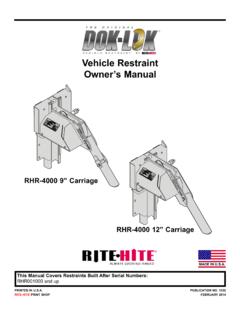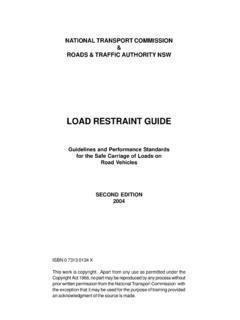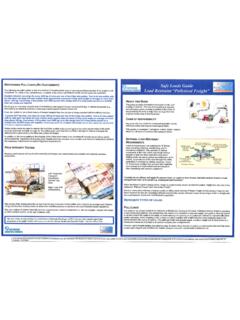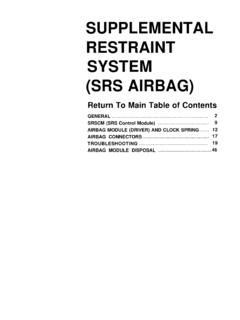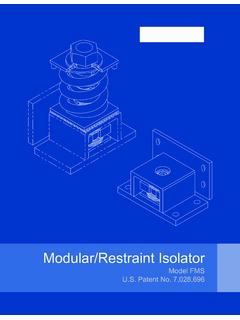Transcription of FACT SHEET CMS Finalizes Hospital Rules on Restraint and ...
1 FACT SHEET CMS Finalizes Hospital Rules on Restraint and Seclusion Produced by Jane Hudson, Senior Staff Attorney National Disability Rights Network January 2007 On December 8, 2006, the Center for Medicaid and Medicare Services (CMS) issued its Final Rule on Hospital Conditions (Patients Rights). 42 ; 71 FR 71378. The Final Rule includes provisions on the use of Restraint and seclusion and applies to all Medicare-and Medicaid-participating hospitals, including short-term, psychiatric, rehabilitation, long-term, children's, and alcohol-drug hospitals. This fact SHEET provides background on the Final Rule and a summary of its main provisions.
2 A. Background Below is a brief timeline concerning the federal statutes and regulations regarding Restraint and seclusion, starting with the Hospital conditions of participation in 1999:1 1999 Interim Final Rule on Hospital Conditions of Participation. The Health Care Finance Administration (HCFA), which later became the Center for Medicaid and Medicare Services (CMS), issued an Interim Rule on the Hospital Conditions of Participation (Patients Rights) on July 2, 1999. 64 FR 36070. CMS received 4200 comments on the Interim Rule within the comment period and held a Town Hall in 2002 to get comments on the so-called One Hour Rule, which in the Interim Rule required a psychiatrist or licensed independent practitioner (LIIP) to conduct a face-to-face evaluation of an individual within one-hour of the initiation of Restraint or seclusion.
3 2000 Children s Health Act. Congress passed the Children s Health Act of 2000 (CHA). 106-310. The CHA includes restrictions on the use of seclusion and Restraint in federally-funded health care facilities (42 290ii et seq. [known as Part H]) and non-medical community-based residential facilities for children and youth (42 290jj et seq. [known as Part I]). According to CMS, the CHA establishes minimum standards for the use of Restraint and seclusion. 71 FR 71378. 2001 Interim Final Rule on Conditions of Participation for Psychiatric Residential Facilities for Individuals under the Age of 21 (PRTFs).
4 CMS issued an Interim Rule on the Conditions of Participation for PRTFs on January 22, 2001. 66 FR 7148. CMS 1 There are also Conditions of Participation for Intermediate Care Facilities for Individuals with Mental Retardation, 42 , and Long-Term Care Facilities, 42 These were issued in the 1990 s and need to be revised to comply with the Children s Health Act of 2000, 42 290ii et seq. and to reflect evidence-based practices. 1 published an additional Interim Final Rule with comment to amend and further clarify the 1/22/01 Interim Final Rule. 66 FR 28110.
5 CMS has not yet issued a Final Rule for PRTFs. 2006 Final Rule on Hospital Conditions of Participation (Patients Rights). CMS issued the Final Rule on December 8, 2006 to comply with deadlines established in the Medicare Prescription Drug, Improvement and Modernization Act of 2003. 42 CFR ; 71 FR 71378. This Rule is the subject of this fact SHEET . 2007 CHA Regulations. CMS has told NDRN that it plans to issue regulations implementing these minimum standards in 2007. The Center for Mental Health Services (CMHS) of the Substance Abuse and Mental Health Services Administration (SAMSHA) has informed NDRN that it plans to issue regulations regarding the non-medical community-based residential facilities for children and youth in 2007.
6 CMS and CHMS have also indicated that they plan to issue conditions of participation for additional specific treatment settings in addition to regulations to implement the minimum standards of the CHA regulations. B. Summary of Provisions of Final Rule - Hospital Conditions of Participation (Patient Rights) Below is a summary of the main provisions of the Final Hospital Rule regarding the use of Restraint and seclusion. The summary notes the differences between the Final Hospital Rule, the previous Interim Final Hospital Rule, and the CHA, where appropriate. 1. Combined Standards.
7 The CHS has one set of Rules that applies to seclusion and Restraint in all federally-funded facilities. 42 290ii et seq. The Interim Final Rule for hospitals contained separate standards for 1) the use of Restraint for acute medical/surgical care and 2) Restraint and seclusion for behavior management. Commentators on the Interim Final Rule felt that it was unclear which requirements applied to which situations. 71 FR 71382. Based on these comments, CMS combined the two standards into one standard called Restraint or Seclusion. 42 (e). Even though CMS has combined the standards, CMS still has some provisions that apply only to Restraint or seclusion used for the management of violent or self-destructive behavior.
8 These specific provisions will be noted where applicable. 2. Definitions: The Final Rule has adopted a uniform definition of Restraint and seclusion across all Hospital care settings. 71 FR 71388. a. Restraint . The definition of Restraint has not significantly changed between the Interim and Final Rule. 42 482(e)(1)(i). Under the Final Rule, a Restraint is: (A) Any manual method, physical or mechanical device, material, or equipment that immobilizes or reduces the ability of a patient to move his or her arms, legs, body, or head freely; or (B) A drug or medication when it is used as a restriction to manage the patient's behavior or restrict the patient's freedom of movement and is not a standard treatment or dosage for the patient's condition.
9 42 (e)(1)(i)(A) and(B). The Final rule excludes the following devices, materials, equipment and methods from the definition of Restraint : orthopedically prescribed devices, surgical dressings or bandages, protective helmets, or other methods that involve the physical holding of a patient for the purpose of conducting routine physical examinations or tests, or to protect the patient from falling out of bed, or to permit the patient to participate in activities without the risk of physical harm (this does not include a physical escort). 42 (e)(i)(C). With respect to the provisions on the definition of chemical Restraint , 42 (e)(1)(i)(B), CMS explains that a medication constitutes a Restraint and is not considered standard treatment if the overall effect of a medication is to reduce the patient's ability to effectively or appropriately interact with the world around the patient.
10 71 FR 713091. b. Seclusion. The Final Rule defines seclusion as the involuntary confinement of a patient alone in a room or area from which the patient is physically prevented from leaving. 42 CFR (e)(1)(ii). This definition is broader than the definition of seclusion in the CHA, which narrowly defines seclusion, as a behavior control technique involving locked isolation. 42 USC 290ii(d)(2) (emphasis added). The preamble to the Hospital regulations is helpful in distinguishing seclusion from time out. In response to commentators concerns about what constituted seclusion and time out, CMS explained that the key distinction between seclusion and time rested on whether an intervention was voluntary and whether the individual had any personal control over when seclusion starts and stops: The key distinction in deciding whether an intervention is seclusion or a time out is whether the patient is physically prevented from leaving a room or area.



